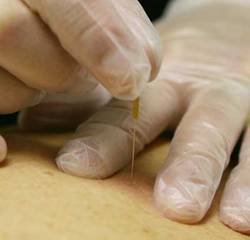 Trigger points are hyperirritable contraction knots found in tight bands of muscles resulting in what we call myofascial pain syndromes. These points are usually associated with muscle tightness and pain. Trigger point pain can often refer down other parts of the body and mimic pain from a pinched nerve resulting in patients undergoing numerous tests. Importantly, trigger points cannot be identified on a blood test, x-ray, MRI or CT scan. The best test for detecting a trigger point is a careful physical exam performed by someone with specialized training in this area.
Trigger points are hyperirritable contraction knots found in tight bands of muscles resulting in what we call myofascial pain syndromes. These points are usually associated with muscle tightness and pain. Trigger point pain can often refer down other parts of the body and mimic pain from a pinched nerve resulting in patients undergoing numerous tests. Importantly, trigger points cannot be identified on a blood test, x-ray, MRI or CT scan. The best test for detecting a trigger point is a careful physical exam performed by someone with specialized training in this area.
Trigger points can cause chronic debilitating myofascial pain with loss in muscle function, strength and coordination. Disabling pain results in inactivity which causes a spiral down effect of worsening the pain, further tightening of painful muscles and involvement of other parts of the body. In fact, patients with myofascial pain syndrome are often diagnosed with overlapping fibromyalgia which may not be completely accurate.
Trigger point dry needling utilizes a very thin filament needle. The needle used is similar to an acupuncture needle but this treatment is not considered acupuncture and is based on Western physiologic approaches and not eastern meridian points. The needle is inserted into the trigger point and a local twitch response is ideally elicited but often not necessary to achieve results.
Dry needling is thought to work by disrupting a reflex arc of contracted tissue as well as stimulating biochemical changes to allow improved blood flow and healing to the area. The twitch response is an involuntary contraction of the muscle that allows the muscle to relax permitting blood flow to an area which was normally deprived of oxygen and flushing out of painful waste products, free radicals and cytokines. Sometimes electrical stimulation is applied to the needle to elicit these twitches to help the muscle relax as well.
Patients with acute or chronic pain disorders emanating from trigger points may benefit from trigger point dry needling. This technique differs from trigger point injections in that no foreign chemicals are being injected into the patient’s body and a much broader area of the body can be treated rapidly.


